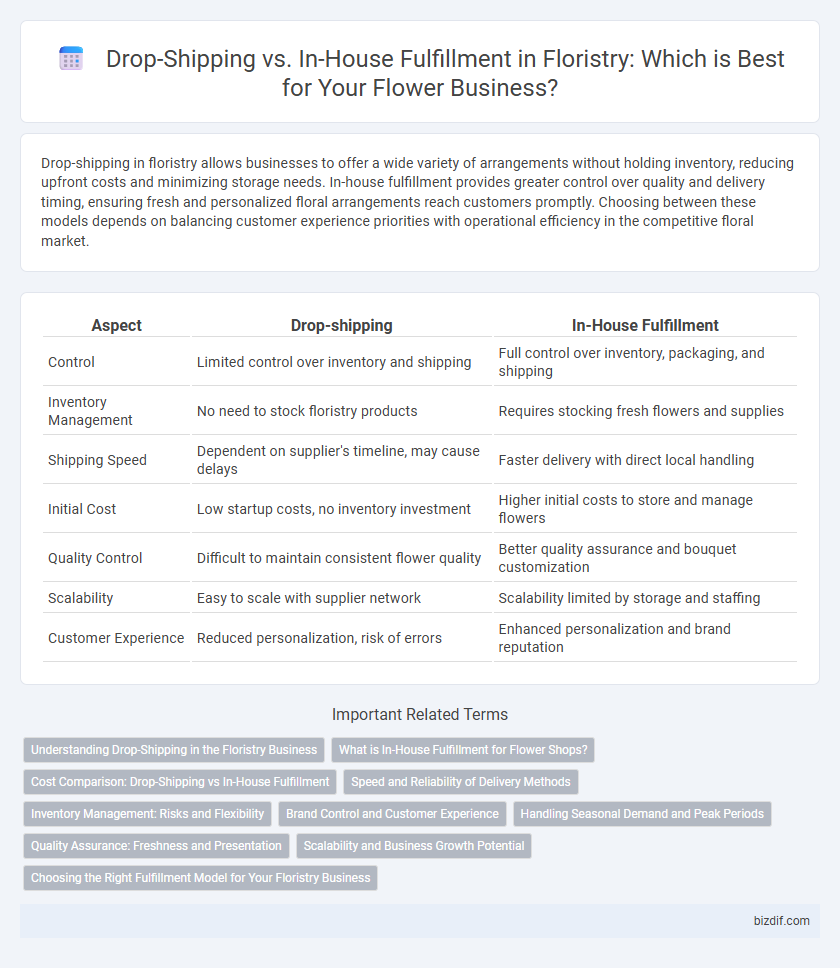Drop-shipping in floristry allows businesses to offer a wide variety of arrangements without holding inventory, reducing upfront costs and minimizing storage needs. In-house fulfillment provides greater control over quality and delivery timing, ensuring fresh and personalized floral arrangements reach customers promptly. Choosing between these models depends on balancing customer experience priorities with operational efficiency in the competitive floral market.
Table of Comparison
| Aspect | Drop-shipping | In-House Fulfillment |
|---|---|---|
| Control | Limited control over inventory and shipping | Full control over inventory, packaging, and shipping |
| Inventory Management | No need to stock floristry products | Requires stocking fresh flowers and supplies |
| Shipping Speed | Dependent on supplier's timeline, may cause delays | Faster delivery with direct local handling |
| Initial Cost | Low startup costs, no inventory investment | Higher initial costs to store and manage flowers |
| Quality Control | Difficult to maintain consistent flower quality | Better quality assurance and bouquet customization |
| Scalability | Easy to scale with supplier network | Scalability limited by storage and staffing |
| Customer Experience | Reduced personalization, risk of errors | Enhanced personalization and brand reputation |
Understanding Drop-Shipping in the Floristry Business
Drop-shipping in the floristry business allows retailers to sell floral products without holding inventory, directly sourcing flowers and arrangements from suppliers who ship orders to customers. This model reduces upfront costs and inventory risks but may limit control over product quality and delivery times. Understanding supplier reliability and communication is crucial for maintaining customer satisfaction and brand reputation in drop-shipping floristry operations.
What is In-House Fulfillment for Flower Shops?
In-house fulfillment for flower shops involves managing the entire order processing, packaging, and delivery operations internally, ensuring quality control and timely customization of floral arrangements. This method allows florists to maintain direct oversight over inventory, bouquet design, and customer service, enhancing personalization and brand consistency. Handling fulfillment in-house often requires implementing efficient workflows and dedicated staff to meet peak demand and special event deadlines effectively.
Cost Comparison: Drop-Shipping vs In-House Fulfillment
Drop-shipping reduces upfront inventory costs and eliminates warehousing expenses, making it cost-effective for low-volume floristry businesses. In-house fulfillment requires investment in storage, labor, and packaging but offers greater control over flower quality and faster delivery times. For florists handling high order volumes, in-house fulfillment often lowers per-unit costs compared to the variable fees and supplier markups associated with drop-shipping.
Speed and Reliability of Delivery Methods
Drop-shipping in floristry offers faster order processing times by directly shipping products from suppliers to customers, bypassing inventory handling and reducing delivery delays. In-house fulfillment provides greater control over packaging quality and inventory management, enhancing reliability and reducing errors but may extend delivery times due to internal processing. Choosing between the two depends on balancing rapid order fulfillment with consistent delivery accuracy for optimal customer satisfaction.
Inventory Management: Risks and Flexibility
Drop-shipping in floristry minimizes inventory holding risks by allowing sellers to list products without physical stock, reducing overhead and mitigating unsold fresh flower waste. In-house fulfillment provides greater control over inventory quality and enables immediate response to demand fluctuations, but requires substantial investment in storage and perishability management. Balancing flexibility and risk is essential; drop-shipping suits businesses prioritizing lower risk and scalability, while in-house fulfillment favors those emphasizing quality control and customer experience.
Brand Control and Customer Experience
In floristry, in-house fulfillment offers greater brand control by allowing meticulous oversight of flower quality, packaging, and presentation, directly enhancing customer experience with personalized and consistent deliveries. Drop-shipping often sacrifices this control as third-party suppliers manage inventory and shipping, potentially leading to variability in bouquet freshness and packaging standards. Maintaining direct fulfillment empowers florists to create memorable, brand-aligned unboxing moments that foster customer loyalty.
Handling Seasonal Demand and Peak Periods
Drop-shipping allows florists to scale effortlessly during peak periods and seasonal demand by leveraging third-party suppliers who manage inventory and shipping, reducing the risk of overstock or stockouts. In-house fulfillment provides greater control over the quality and presentation of arrangements but requires efficient inventory management and additional staffing during high-demand seasons like Valentine's Day and Mother's Day. Strategic planning with accurate sales forecasting is critical for both methods to ensure timely delivery and customer satisfaction during floral peak periods.
Quality Assurance: Freshness and Presentation
Drop-shipping floristry faces challenges in quality assurance, as flowers often travel longer distances and pass through multiple handlers, increasing risks to freshness and presentation. In-house fulfillment enables tighter control over flower selection, conditioning, and packaging, ensuring optimal freshness and visually appealing arrangements upon delivery. Maintaining a consistent brand reputation depends heavily on direct oversight of the fulfillment process to guarantee customer satisfaction with every bouquet.
Scalability and Business Growth Potential
Drop-shipping in floristry enables rapid scalability by eliminating inventory management and allowing access to a broader supplier network, which accelerates business growth without heavy upfront costs. In-house fulfillment offers greater control over product quality and customer experience, fostering brand loyalty but requires significant investment in warehousing and logistics, potentially limiting fast expansion. Choosing the right fulfillment strategy depends on balancing immediate scalability goals with long-term brand development and operational capacity.
Choosing the Right Fulfillment Model for Your Floristry Business
Choosing the right fulfillment model for a floristry business impacts product freshness, delivery speed, and customer satisfaction. Drop-shipping reduces inventory costs and allows access to a wider range of floral varieties by partnering with suppliers who ship directly to customers, but may limit control over quality and timing. In-house fulfillment ensures hands-on care of delicate flowers and faster order processing, enhancing brand reputation and customer trust in product freshness.
Drop-shipping vs in-house fulfillment Infographic

 bizdif.com
bizdif.com